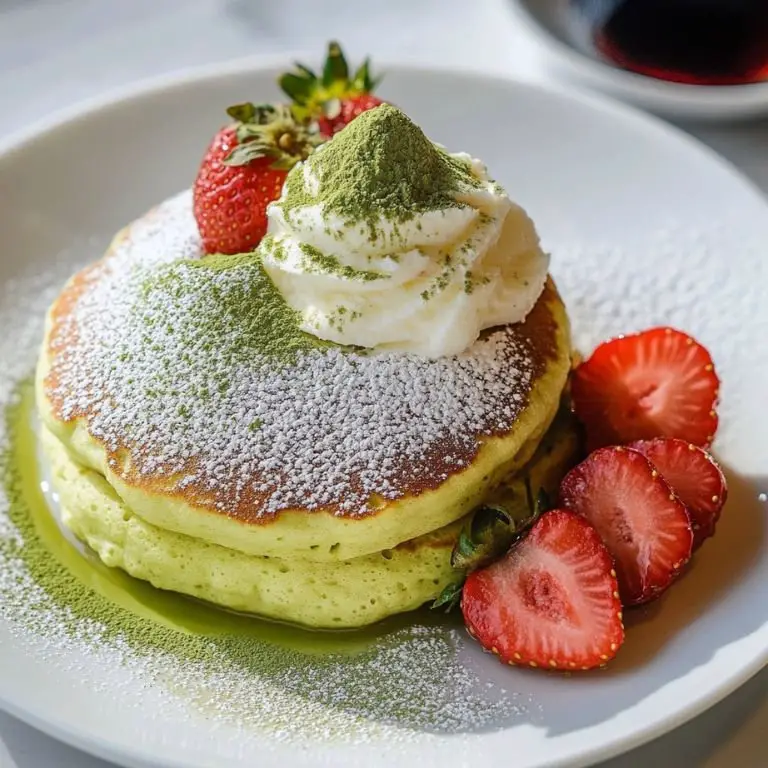If you’re looking for a brunch upgrade or a dessert that makes people do a double take, these matcha Japanese soufflé pancakes are it. With their signature jiggly wobble and dreamy soft texture, they combine the lightness of a soufflé with the earthy richness of Japanese green tea. This version infuses the batter with matcha, giving the pancakes a delicate bitterness that perfectly balances their sweet toppings. Whether you’re diving into how to make Japanese pancakes for the first time or adding to your list of unique breakfast ideas, these matcha beauties are a recipe worth mastering.
Matcha Japanese Soufflé Pancakes
Prep Time 15 minutes mins
Cook Time 15 minutes mins
Total Time 30 minutes mins
Course Brunch, Dessert
Cuisine Japanese
Nonstick skillet with a lid for steam-trapping magic
Electric mixer unless you’re up for a serious arm workout
Ring molds (3-inch diameter) key to that tall, café-style rise
Small spatula and ladle for gentle batter handling
Fine mesh sifter to keep the matcha smooth, not clumpy
- 2 large eggs separated
- 2 tablespoons milk
- 1/4 teaspoon vanilla extract
- 1/4 cup all-purpose flour sifted
- 1 tablespoon matcha powder culinary grade for best flavor
- 1/4 teaspoon baking powder
- 2 tablespoons granulated sugar
- Butter for greasing the pan
- Powdered sugar whipped cream, and fresh fruit for serving
- Sweetened red bean paste optional, but amazing
Separate Your Eggs
Carefully separate the yolks from the whites. Place whites in a clean, dry mixing bowl.
Whisk the Yolks
In another bowl, whisk together egg yolks, milk, and vanilla extract until smooth. Sift in the flour, baking powder, and matcha powder. Mix just until combined.
Make the Meringue
Beat the egg whites with an electric mixer. When they start to foam, gradually add the sugar. Continue beating until stiff peaks form—this is what gives these pancakes their soufflé structure.
Fold It In
Gently fold the meringue into the matcha batter in thirds. Be patient and don’t overmix—airy batter is your goal.
Heat & Grease
Preheat your skillet over low heat. Lightly grease it with butter and place your ring molds on the pan.
Fill the Molds
Spoon batter into the molds about three-quarters full. Cover with a lid and let them steam-cook for about 6–7 minutes.
Flip Gently
Using a spatula, carefully flip the pancakes and cover again. Cook another 6–7 minutes until firm but jiggly.
Serve Immediately
Remove molds, dust with powdered sugar, and top with berries, whipped cream, or a dollop of red bean paste for a more traditional Japanese breakfast twist.
Perfect Pairings
Serve your matcha pancakes with a hot cup of genmaicha or hojicha for a mellow, toasty pairing. For a sweet finish, a drizzle of kuromitsu (japanese black sugar syrup) makes them feel right at home in your dessert recipes lineup. Want to turn these into a brunch-meets-dinner treat? Add grilled fruit, or go full-on creative with a scoop of vanilla ice cream and a drizzle of condensed milk—your dinner ideas just got sweeter.
FAQs
1. Can I use matcha latte mix instead of matcha powder?
It’s better to stick with pure culinary-grade matcha. Latte mixes often have added sugar and milk powder, which can throw off the texture and flavor.
2. What’s the difference between soufflé pancakes and japanese hot cakes?
Japanese hot cakes are thicker and cakier, often cooked in a pan like American pancakes but with a more uniform structure. Soufflé pancakes are super light and airy, thanks to the whipped meringue folded into the batter.
3. Do I need ring molds?
They help a lot! Without them, the batter tends to spread and flatten. But in a pinch, parchment collars or DIY foil rings can work.
4. Are these considered a breakfast or a dessert?
Both! They’re popular in japanese breakfast recipes, especially at cafes, but are equally at home as part of a stunning plated dessert.
5. Could I make these savory for an easy dinner recipe?
Absolutely. Skip the sugar and vanilla, and try adding grated cheese and herbs. A savory matcha pancake with miso butter could totally belong in your list of easy dinner recipes.
6. How do these compare to japanese crepes?
Totally different texture. Japanese crepes are thin, chewy, and flexible—great for wrapping fillings. Soufflé pancakes are thick, fluffy, and fork-only territory.
